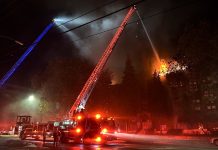
Nov. 13 (UPI) — Humans regularly cause wildfires in California and elsewhere. They flick cigarettes into dry brush or leave campfires poorly contained.
Humans can also influence the size and severity of wildfires. Human-caused global warming and aggressive wildfire suppression — the longtime approach of federal and state forest management — explain the recent spate of deadly fires raging across California, research shows.
“California was particularly hot and dry this summer, which has exacerbated wildfire conditions. Dozens of studies suggest human-caused global warming explains the increase in the frequency, severity and length of heatwaves and droughts.
Hot and dry conditions increase the odds of wildfires, but even without extreme conditions, rising global temperatures — the result of increasing CO2 and other greenhouse gas emissions — make wildfires more likely.
Several studies have found global warming is effectively lengthening the wildfire season by coaxing the early arrival of spring and prolonging the end of autumn.
“The changing seasonal cycle provides powerful and novel evidence for a significant human effect on Earth’s climate,” Benjamin Santer, an atmospheric scientist at the Lawrence Livermore National Laboratory in California, said earlier this year.
In addition to raising temperatures and prolonging fire season, research suggests climate change is also slowing weather patterns, increasing the odds that extreme weather patterns stick around. Extreme heat plagued California for much of the summer, and several studies suggests a slowing jet stream is one reason why.
As the Arctic warms, the temperature gradient that drives the jet stream is weakening. Scientists think a slower, more sporadic jet stream helps explain the increase in extreme weather and holding patterns. The phenomenon can explain both prolonged droughts and extreme precipitation events.
“The heat waves and drought that are related to such jet stream extremes happen on top of already increasing temperatures and global warming — it’s a double whammy,” Valerie Trouet, a scientist at Arizona’s Laboratory of Tree-Ring Research, said in January.
Over the last several decades, as humans accelerated climate change, they also expanded into fire-prone regions, building homes that require protection. Many researchers think aggressive fire suppression policies have kept forest unnaturally thick, making them more prone to severe fire when flames grow out of control.
Unfortunately, all of these phenomena fuel negative feedback loops. Studies suggest smaller shrubs and trees — more fire-prone species — can outcompete larger trees in forests degraded by heat, drought and fire, ensuring the next fire will be worse than the last.
“As the climate continues to warm, big severe wildfires will be more frequent, and the dry conditions that follow will increasingly favor shrubs over conifers,” Harvard ecologist Jonathan Thompson said in April.
One study found wildfires in Africa encourage drought conditions, which in turn, make wildfire more likely.
No research can prove that global warming alone caused a single fire, including the fires currently raging across California. But the growing body of climate science research suggests wildfires will remain a growing problem as long as humans continue to alter the climate. And as large fires continue to rage, carbon will be returned to the atmosphere, impeding the goal of limiting global temperature increases to less than 2 degrees Celsius.





